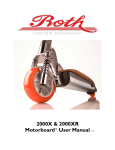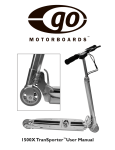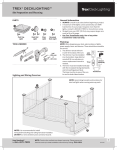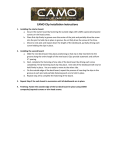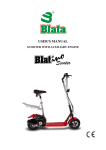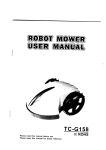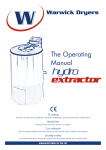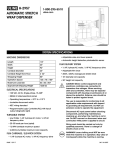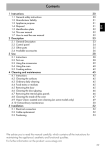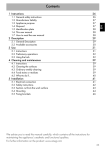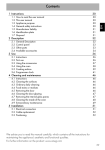Download 2000X User Manual V1.7.pub
Transcript
2000X TranSporter™ Motorboard™ User Manual V1.7 IMPORTANT Battery Maintenance and Charging Instructions 1. You MUST charge your battery completely prior to initial use. This means charging it for at least 2 hours. 2. Typical charge time is 120 minutes. 3. Charge before storage. You must charge every 30 days if not in use. 4. Only use the charger provided. 5. The Motorboard can be left on the charger indefinitely without harming the battery. 6. Turn the Motorboard OFF when charging and when not in use. 7. You can read a more detailed battery charging guide later in this manual. Safety Instructions This product is not intended for extreme or off-road use. Please take proper care of your Motorboard. Do not jump or abuse this product. Do not operate with the power switch OFF. Do not operate at speeds above 15 mph. Do not ride in wet conditions or on steep inclines. Always ride safely and wear appropriate protective gear. If you have any questions, please contact us at [email protected] or on the Web at www.gosportinggoods.com. Failure to follow these instructions will VOID YOUR WARRANTY! Get Ready... Congratulations on the purchase of your new 2000X TranSporter™ Motorboard.You’re in for a great ride.You can Go faster, farther, more safely and silently than ever on a motorized scooter. Plus, you can quickly recharge and Go again. Note: It is highly recommended that the user be well-coordinated and be a minimum of 16 years of age. Your Go Motorboard™ is unlike any other powered scooter on the market today. Your Motorboard is not a toy! It is equipped with the most advanced Drive System available, which is comprised of TWO electric motors with Computerized Speed Control. This is a new class of high-performance Motorboard combining advanced technology, materials, durability, safety features, nonpolluting “green” power, and value. It is extremely important to read this User Manual before operating your Go Motorboard™. This manual includes key information regarding setup instructions, use, maintenance, and safety procedures that will show you how to obtain maximum performance from your Go Motorboard™. This User Manual applies only to the 2000X TranSporter Motorboards. 2000X Contents of your Go Motorboard™ carton: 1. Go Motorboard™ 2. 110v — 220v battery charger 3. User Manual 4. Tire Gauge Get Set... Please read the following information to properly setup your Go Motorboard™ for first-time use. Unfold your Motorboard: 1) Place your folded Go Motorboard™, deckboard side up, on the floor or other solid, even surface. (Fig. A) 2) Locate the Folding Lever. (This is a large lever located near the Front Wheel and is adjacent to the Master Hinge at the base of the Steering Column.) With your thumb, firmly press down and hold the Folding Lever. (Fig. B) 3) With your other hand, hold the Steering Column and pull up until it stops at an approximately 30-degree angle. Your Go Motorboard™ is now in the Kickstand Position. (Fig. C) Secure Handlebars: 5) Locate the Foam Grips. (They are hanging from the Handlebar at the top of the Steering Column on elastic cords). Pick up the right hand Foam Grip and insert the metal shaft into the hole on the right side of the handlebar. Rotate the Foam Grip forward/clockwise until you hear a click and the Battery Gauge is in view facing upward. (Fig. D) 6) Locate the spring-loaded Handlebar Button. (This pencil eraser-sized button is located on the metal shaft part of the foam grip.) Press in the Handlebar Button with your thumb, while sliding the foam grip into place with your other hand. The Handlebar Button will click/lock into place in a small hole in the Handlebar. Repeat the same procedure for the left hand Foam Grip with the Brake. (Fig. E) Extend Steering Column: 7) Locate the Steering Column Nut. (This is a large, 1 1/2" diameter nut located at the base of the Steering Column.) Loosen/turn the Steering Column Nut counterclockwise. Slowly pull the Steering Column upward until it is fully extended and clicks/locks into place. IMPORTANT: THE STEERING COLUMN MUST BE FULLY EXTENDED AND LOCKED INTO POSITION FOR SAFE USE. 8) Tighten/turn the Steering Column Nut clockwise. It should be tightened very firmly by hand. (Fig. F) Do not use a wrench or other tool to tighten. The setup of your Go Motorboard™ is now complete. Please read the following information prior to using your Go Motorboard for the first time. Survey the Landscape: Find a safe, clear, smooth area that is free of pedestrian and vehicular traffic. Turn the Power “ON”: IT IS HIGHLY RECOMMENDED TO FULLY CHARGE THE BATTERY PRIOR TO EXTENDED USE. Locate the “ON/ OFF” (Power) Switch under the Deckboard, on the right side, and turn the unit “ON.” You will see a green light on the Speed Controller. (Fig. G) IMPORTANT: ALWAYS TURN THE POWER “ON” BEFORE RIDING. NEVER OPERATE THIS VEHICLE WITH THE POWER SWITCH IN THE “OFF” POSITION OR YOU MAY DAMAGE THE ELECTRONICS. You can operate your Go Motorboard™ alternately as a push scooter and as a motorized Motorboard, as long as the power switch is turned “ON” prior to any use. Practice pushing yourself around: From the Kickstand Position, place your Go Motorboard™ into Riding Position by pushing the Handlebars forward until the Folding Lever locks into place. Your Go Motorboard™ is now in Riding Position. To return to Kickstand Position, firmly pull back the Folding Lever with one hand while pulling the Foam Grip/Handlebar back with your other hand. Practice with your Go Motorboard™ as a PUSH SCOOTER until you feel comfortable riding without the speed of the electric motors. Grasp the Foam Grips on the Handle Bars with both hands, place one foot on the Deckboard, and push-off a few times with your other foot to move forward. IMPORTANT: NEVER ATTEMPT TO DRIVE YOUR GO MOTORBOARD™ IN REVERSE. YOU MAY DAMAGE THE ELECTRONICS. Practice Starting the Drive System: Your Go Motorboard™ has a unique power-saving, safety feature that ensures that the electric motors do not engage until the vehicle is traveling in excess of 3 m.p.h. To Accelerate: Push-scoot your Go Motorboard™ to 3 m.p.h. and, when you are ready to accelerate, use your right index finger to gently squeeze the Speed Controller Trigger located above the right-hand Foam Grip. Your Go Motorboard™ electric motors are now engaged. Gently continue squeezing the Speed Controller Trigger until you attain the desired speed. You can control speeds within a range of 3mph to a maximum of 15mph. Practice riding your TranSporter on a flat safe area. Go slowly and practice accelerating, decelerating, and braking. Do not go any faster than your skills allow. ALWAYS WEAR AN APPROVED SAFETY HELMET AND OTHER SAFETY GEAR WHEN RIDING YOUR MOTORBOARD. Braking System: THIS SECTION DESCRIBES BOTH AVAILABLE BRAKING SYSTEMS! PLEASE READ CAREFULLY! To Decelerate: While riding your Go Motorboard™ with the electric motors engaged, release the Speed Controller Trigger and the unit will coast. You can then engage one of the two available braking systems. Primary Braking System: Pull the hand brake lever to engage the rear brake. IMPORTANT: THIS BRAKE IS NOT EFFECTIVE WHEN GOING DOWN STEEP INCLINES OR LONG, SHALLOW GRADES. USE THE SECONDARY BRAKING SYSTEM INSTEAD. Secondary Braking System: The secondary braking system on the Go Motorboard™ is engaged by placing the heel of your shoe on top of the rear wheel, and applying pressure. By varying the amount of pressure, you can vary the amount of braking power. Make sure that when operating the Go Motorboard™ you are wearing appropriate footwear in order to operate this braking system. This technique is especially effective when riding down small hills. Coasting: Remember to always ride with your TranSporter in the turned “ON” position. To COAST, while in motion, release the Speed Controller Trigger completely. While coasting, you will gradually lose speed. You can accelerate again at any time by squeezing the Speed Controller Trigger. You can accelerate and coast intermittently at speeds above 3 m.p.h. You may also push-scoot and coast intermittently, speed permitting. Once your speed falls below 3 m.p.h., you must push-scoot up to the 3 m.p.h. speed again in order to engage the electric motors and accelerate again. To brake while coasting, follow normal braking procedures. Go... Don’t GO into or over water: 1) IMPORTANT: EXPOSURE TO WATER MAY CAUSE SEVERE DAMAGE TO THE REAR TIRE AND/OR DRIVE SYSTEM. IF YOU ACCIDENTALLY DRIVE THROUGH WATER, STOP IMMEDIATELY, DRY YOUR REAR WHEEL, AND INSPECT FOR DAMAGE. Listen for clicking or knocking sounds when riding. Check the rear tire for chewed-out notches or ground rubber “grit” similar to the residue you see from a used eraser. 2) If the rear tire has been damaged, replace it as soon as possible before riding again. 3) Carry a small piece of absorbent cloth to use in case of accidental water exposure. Use Caution Going Uphill Riders over 200 lbs., or those ascending steep inclines, can unduly strain the drive system, resulting in serious damage. IMPORTANT: IF YOUR MOTORBOARD CANNOT MAINTAIN A SPEED OF 5 M.P.H. AT FULL THROTTLE ON AN INCLINE, THE INCLINE IS TOO STEEP. IMMEDIATELY RELEASE THE SPEED CONTROLLER TRIGGER FULLY AND KICK SCOOT TO ASCEND. FAILURE TO DO SO MAY RESULT IN SERIOUS DAMAGE. Use Extreme Caution Going Downhill Riding the Motorboard downhill can be extremely dangerous, because extreme speeds can be reached. The braking systems were not designed to stop the Motorboard at excessive speeds. When riding downhill, you should engage the Secondary Braking System by placing your heel on the rear wheel and applying pressure. This will slow the Motorboard and prevent it from reaching unsafe speeds. NEVER OPERATE THE MOTORBOARD AT SPEEDS GREATER THAN 15 M.P.H., or at any speed that you cannot safely exit the Motorboard on foot. Know your abilities, and always wear the proper footwear! How to Fold Up Your Go Motorboard: The TranSporter™ is unlike any transportation device on the market today in terms of its light weight (19.5 lbs.), compact size, and unprecedented portability. With your Go Motorboard™, you can ride to your destination, fold it, and carry or stow it almost anywhere. Lowering Your Steering Column: 1) Locate the Steering Column Nut. This is a large 1 1/2" diameter nut located at the base of the Steering Column. Loosen/turn the Steering Column Nut counterclockwise. (Fig. K) 2) Locate the spring-loaded Steering Column Button. This pencil erasersized button is located on the front of the Go Motorboard™ 5 inches below the Steering Column Nut. Depress the Steering Column Button and, with your other hand, slowly push the Steering Column downward. (Fig. L) Folding Your Go Motorboard™: 1) Locate the Folding Lever. This is a large lever located near the Front Wheel and is adjacent to the Master Hinge at the base of the Steering Column. With your thumb, firmly press down and hold the Folding Lever. (Fig. M) 2) With your other hand, hold the Steering Column and pull down until it stops. Your Go Motorboard™ is now in the Folded Position. (Fig. N) Turn Off the Power After Each Use: Remember to turn your Go Motorboard™ off after each use. Keeping the power “ON” for intermittent use throughout the day does not substantially affect battery life. However, you should turn the power “OFF” if you do not plan to ride within 12 hours. Regular Maintenance: Keep It Clean. Keep It Going. 1) Your Go Motorboard™ is NOT a toy. It is a serious transportation device that requires regular cleaning and attention to maintain peak performance. IMPORTANT: WHEN CLEANING YOUR GO MOTORBOARD™, DO NOT USE A WATER HOSE, RUNNING WATER, OR WATER UNDER PRESSURE IN DIRECT CONTACT WITH THIS UNIT. ALSO, DO NOT CLEAN WITH COMMERCIAL CLEANSERS. MANY WILL LEAVE A SLIPPERY RESIDUE THAT WILL INHIBIT PERFORMANCE OF OR DESTROY THE TIRE MATERIAL AND CAUSE PERMANENT DAMAGE. 2) Remove embedded dirt and debris using a soft bristled brush such as an old toothbrush. Pay special attention to pins, hinges, and spaces around the Folding Lever and Front Tire. 3) Make a diluted solution of mild laundry detergent and water. Use one teaspoon laundry detergent to one gallon of water. 4) Wipe aluminum, wood parts, and tires with a soft cloth or sponge that has been slightly dampened with a diluted solution of mild detergent and water. Tires may also be cleaned with a soft cloth or sponge slightly dampened with 70% pure isopropyl alcohol. (Do not flood the tires with alcohol, which can thin the lubricant on the tire’s bearings.) Condition Your Battery. Every 10 charges, make sure to ride the scooter to completely empty. This is done by turning the power switch, located on the side of your scooter, off and back on after the scooter’s automatic low power shut off is engaged ( blinking red LED). Ride the scooter until it shuts down again. Do this 1 or 2 times more. Wait 10 minutes and charge until the charge cycle is finished (approximately 120 minutes). Check Your Tires. Check to make sure that the tires are not too tight or loose. Using the enclosed Tire Gauge, always check for wear and tear, and replace worn-out or damaged tires as soon as possible. Contact your dealer or go to our web site, www.gosportinggoods.com, to purchase replacement components. Keepin’ It Going... Keep It Lubricated: A little oil goes a long way. Clean and lubricate the folding mechanism. Use just a drop or two of 3-in-1™ oil or 5w-30w synthetic motor oil on a Q-Tip™ to lubricate the spot where the Hinge Pin slides in and out of the locking position on each side of the Steering Head. Also apply just one drop of 3-in-1™ oil or 5w-30w synthetic motor oil at each pivot point. It’s very important to use just a small amount of oil when lubricating the folding mechanism. Using excessive oil causes your Motorboard to become overly sticky, resulting in trapped dirt and grit. This excess dirt and grit can damage the unit. Also, conventional motor oil gets sticky very quickly compared to synthetic motor oil or 3-in-1™ brand oil. Clean and lubricate the steering mechanism by applying one drop of 3-in-1™ brand oil at each part of the Steering Hinge. As with the folding mechanism, any excess lubricant can attract dirt and grit and damage the steering components. Removing a Tire: Removing a tire from your Go Motorboard™ TranSporter for cleaning, lubrication, or replacement is quick and easy. Use an adjustable wrench to remove the nut from the wheel axle bolt. Once the wheel axle bolt is removed, the tire will be free. Changing Your Deckboard: Your Go Motorboard™ TranSporter has multiple Deckboard designs available so you can change the look of your Go Motorboard™ to suit your taste or mood! To remove the Deckboard, simply unscrew the deck screws with a sturdy Phillips screwdriver. Avoid leaving the battery unprotected for any extended period of time. DO NOT ATTEMPT TO TAMPER WITH ANY OF THE ELECTRONICS BELOW THE BOARD ONCE REMOVED AS THIS MAY DAMAGE THE UNIT AND VOID YOUR WARRANTY. Maintaining the Drive System and Using the Tire Gauge: Your Go Motorboard™ is a high-tech, high-performance personal transport equipped with one of the most efficient and innovative drive systems ever made for a scooter or any other vehicle. The drive system uses no gears, no belts, not even a chain. It is silent, vibration free, and weighs less than 3 grams. The rear tire of your Motorboard™ is actually part of its TRANSMISSION. Rather than using large, noisy, complicated gears or chains that are messy, noisy and difficult to service, the Go Motorboard™ transmission works simply by pinching the rear wheel between two custom-wound motors. It is perfectly normal for the rear wheel sidewalls to wear down with use, much as it is normal for any tire to wear with time. The sidewalls were designed to wear down at the same rate as they would on normal tire treads with respect to environmental factors such as dirt and sand. The cleaner the road, the longer your tires will last. In order to function at peak performance, the rear wheel must have a minimum sidewall thickness to operate. Please use the Tire Gauge (included) to determine when your tire needs to be replaced. Using the Tire Gauge: The Tire Gauge is actually three tools in one: 1) Check tire wall thickness 2) Check for flat spots on the tire 3) Tire crown, or the cross section of the tire 2 3 1 Checking the Sidewall: 1) IMPORTANT: There are two motors, one on each side of the tire, so it is important to check both sides of the tire. 2) Wipe off the grey-blue rim and tire in the area you will be checking. 3) Position the Tire Gauge on the rear tire as shown in the picture to the right. The Tire Gauge sits on the plastic rim of the wheel, next to the orange tire. 4) The orange material of the sidewall must be higher (thicker) than the thickness of the Tire Gauge. If it is just level or thinner, then its time to replace the tire. Checking for Flat Spots: 1) Position the Tire Gauge on the rear tire as shown. Run the Tire Gauge along the tire, and make sure it maintains full contact with the tire. Any flat spots, bald, or skidded areas in the tire should become apparent. Excessive flat spots will result in extensive vibration, and will require you to change your tire. To avoid excessive wear of your tire, avoid skidding, or locking up the wheel to stop. Checking the Cross Section: 1) Position the Tire Gauge on the rear tire as shown. The Tire Gauge should fit snugly over the tire. The center of the tire should be very close to the gauge. The maximum gap should be less than 3 mm (1/8” ). In addition to the above wheel checks, make sure the sidewalls are smooth and free of any notches. Sidewalls with notches or grooves can create clicking or knocking sounds. Notches are VERY HARD on the motors. A TIRE WITH SIDEWALL GROOVES MUST NOT BE USED OR YOU **WILL** DAMAGE THE MOTORS!!!! A rear tire sustaining minor SIDEWALL DAMAGE OR WEAR only can be temporarily “swapped” for the front tire. Do not swap tires if either tire is damaged or heavily worn. Replace rear tire as soon as possible. Frequently Asked Questions... How do you keep the battery at peak performance? Your new Go Motorboard™ 2000X has an advanced NiMH battery like the ones used in hybrid cars. To get the most out of this new technology, make a habit of “conditioning” your battery. Every 10 charges, make sure to ride the scooter to completely empty. This is done by turning the power switch, located on the side of your scooter, off and back on after the scooter’s automatic low power shut off is engaged ( blinking red LED). Ride the scooter until it shuts down again. Do this 1 or 2 times more. Wait 10 minutes and charge until the charge cycle is finished (approximately 120 minutes). FOR BEST RESULTS, DO NOT DISCONNECT THE CHARGER BEFORE THE BATTERY HAS BEEN FULLY CHARGED. What if all three Speed Controller lights (green, yellow, and red) are illuminated? If this occurs, the computerized “Smart System” has detected a hazardous condition. Shut down the throttle immediately to protect your Motorboard. This alert may have been caused by water, by a sharp bump during acceleration, or if the rear wheel was not on the ground during acceleration. How can the indicator lights be reset? You can reset any light sequence and system shut-down by turning “off” the power switch, waiting five seconds, then switching it “on” again. What if the red light glows slightly when riding, even when the green indicator light is bright? This is a harmless sequence that has no effect on performance, range, or speed. It is usually noticed at twilight or in low-light conditions. What if the indicator light is flashing red and the drive does not function? This means your battery is fully discharged. You must recharge the battery. The drive will not function when the battery is discharged and the red light flashes. What causes low performance? A common cause of low or slow performance is simply a low-level battery charge. You will notice slightly diminished performance when your battery gets below the medium charge level. At that point, it’s time to recharge the battery. Another cause of poor performance could be that the sidewalls of your rear tire have been compromised either by normal wear, riding through water, or using too much power on a steep hill. In these cases, the drive system will slip and be only about 1/3 as powerful. If you have not previously done so, you can swap the front and rear wheels to remedy this situation. After both wheels have been used in the drive system, then a new wheel must be purchased. What if I hear a persistent clicking noise coming from the rear wheel? If you hear a clicking or knocking when riding, check your rear wheel for notches chewed out by the drive spindles and for ground rubber “grit” similar to the residue you see from a used eraser. The clicking noise may also be the result of a cracked wheel due to hard “scrubbing” or cornering with a heavy rider. Care should be taken to prevent conditions that lead to wheel breakage. Although two TranSporter wheels can carry the weight of a medium car, it is possible to crack them. Jumping curbs can cause wheels to crack or fracture. The wheels may crack near the bearings with repeated abuse. Traveling with notches or cracks in the sidewalls of your rear tire may damage one or both motors. If this type of tire damage has occurred, the wheel, bearings, and spacer should be replaced immediately. What if I have to travel with a damaged rear wheel? Some tips for emergency travel: 1) If the wheel is wet, then you should dry it, especially the sidewalls. 2) If you see the “eraser grit” on the sidewalls, use your thumb to rub as much off as you can. 3) Swap the front and rear tires as soon as possible. Using the damaged tire in the front will not reduce the performance. However, you should replace the damaged tire as soon as possible and ride at a reduced, safer speed. Why am I having difficulty folding my Motorboard? Avoid using extra force to move the folding mechanism. Crunching or grinding resistance is caused by trapped grit. This grit can gouge the aluminum parts if you forcefully move the folding mechanism. Thoroughly clean the entire Motorboard and lubricate it before attempting to fold it again. Can I leave the Motorboard plugged into the charger? Yes. You can leave the charger on the Motorboard indefinitely without harming the battery. What is the Tire Gauge? The Go Motorboard drive system works by having the motors make direct contact with the sidewalls of the rear wheel. It is normal that over time, the sidewalls of the rear wheel will wear down, and eventually cause degraded performance. The rear wheel and the front wheel can be swapped, but once both wheels have worn down, a new wheel must be purchased. You can use the included Tire Gauge to help you determine when the rear wheel is worn down. Detailed instructions on its use can be found on our web site, www.gosportinggoods.com. Why do the lights on the charger blink red-green-red-green? There are three reasons that the lights may blink in this manner. First, you must plug the charger into the Motorboard first, then plug the power cord into the wall socket. If you do not follow this procedure, the charger lights will blink red-green, and no charging will occur. Second, if you attempt to charge a hot battery, immediately after riding, the charger lights may blink red-green. If this occurs, wait 10 minutes for the battery to cool, then charge the battery. Third, if you attempt to charge the Motorboard and the ambient temperature is less than 60 degrees Fahrenheit, the charger lights may blink red-green. If this occurs, bring the Motorboard up to room temperature, and try to charge again. Go Safely... Take a few moments to review the following safety precautions designed to keep you safe and sound while riding your Go Motorboard™. Use common sense and courtesy when riding. WARNINGS... THIS IS NOT A TOY! The recommended minimum age for use of this Motorboard is 16 years of age. • • • • • • • • • • • • • • The Go Motorboards™ are not intended for use on public streets, roads, or highways. We encourage you to check into your local city ordinances and state laws and/or statutes and restrictions regarding use of push electronic Motorboards or scooters. ALWAYS wear an approved safety helmet, goggles, protective elbow and kneepads, and always wear proper footwear. DO NOT ride this Motorboard in the rain or in wet conditions. Wet weather impairs traction, braking, and visibility. The risk of accident is dramatically increased in wet conditions. Riding after dark or at times of poor visibility is DANGEROUS. Avoid roadways, paths, or other areas used by motor vehicles. Avoid sandy areas. DO NOT operate at speeds greater than 15m.p.h. The braking systems are not designed for use at high speeds. DO NOT stunt ride. Ride in control at all times! DO NOT carry passengers or operate with more than one rider operator. DO NOT operate this Motorboard in traffic or on wet, frozen, oily, or unpaved surfaces. Avoid potholes and surface cracks. DO NOT jump off curbs. DO NOT operate while under the influence of drugs or while intoxicated. DO NOT immerse in water because it will damage the Motorboard’s electronic components. IMPORTANT SAFETY WARNINGS • Recycle or dispose of batteries properly and in accordance with local regulations for lead acid batteries. • Before each use, inspect your Motorboard thoroughly for loose or missing parts. • DO NOT leave the Power Switch ON when not in use. • DO NOT place your Go Motorboard™ near fire or heat as this may cause the battery to explode. • DO NOT expose the charger or Go Motorboard™ to moisture or water. • Keep hands, face, feet, and hair away from all moving parts. • Your Motorboard is designed to only start by kicking off first. This is a safety feature. YOUR INSURANCE POLICIES MAY NOT PROVIDE COVERAGE FOR ACCIDENTS INVOLVING THE USE OF THIS SCOOTER. TO DETERMINE IF COVERAGE IS PROVIDED, YOU SHOULD CONTACT YOUR INSURANCE COMPANY OR AGENT. NOTE: • The status of the Go Motorboard™ as a “motor vehicle” is subject to driver’s licensing, insurance, and registration requirements, which vary from state to state. • Check with a reliable authority in your state to see if the Go Motorboard™ must be registered as a motor vehicle. Your police department or local department of motor vehicles may be able to answer your questions or direct you to a reliable authority. The recommended age and minimum weight for the Go Motorboard™ is 16 years or older and between 100 and 250 pounds. This is subject to the physical coordination of the rider and the ability of the rider to wear protective gear and to take responsibility for his/her own actions. Features: • • • • • • • • • • • • • • • • • Ultra-Light Weight construction, the Motorboard weighs only 19.5lbs. Advanced NiMH battery technology, the same used in hybrid cars. 750-watt high-torque custom twin motors that produce one horse power and weigh an amazing 12 oz. each. “Bulletproof” polycarbonate wheel hub; three times stronger than other hubs. Advanced microprocessor-controlled motors. Pulse Width Modulated (PWM) at 100,000 times per second. Three-second folding and locking mechanism. Tough, aerospace-grade 6061 T6 aluminum body, heat-hardened. “Always on” free wheeling system. The scooter glides with or without power. Ergonomic variable-speed throttle, 38" steering column and low deck for efficient kicking and dismounting. Single-stroke folding lever with an integrated kneeling kickstand. Silent and silky gearless drive system is both highly efficient and vibration-free. The drive system weighs only 6 grams. Solid bushing hinge is stronger than the “tricycle class” unit found on most scooters. High-Performance polyether tires. High rebound and durability makes average polyurethane skate wheels look like stone-age relics. Antilock lever-actuated rear brake. Precision steering for excellent slow- and high-speed maneuvering. Easy-view color battery gauge. High-Performance Spring Suspension System for a smooth ride through the Urban Jungle. Limited Warranty: Go Sporting Goods, LLC, warranties our Motorboards to be free of manufacturing defects for a limited period from the date of purchase from an authorized retailer. This Limited Warranty does not cover normal wear and tear, nor any damage, failure, or loss caused by improper assembly, maintenance, storage or use of the product. Please visit our web site at www.gosportinggoods.com for the full terms and conditions of the Limited Warranty. Warranty shipping is the responsibility of the customer. Go Sporting Goods, LLC Contact Information: Web Site: Email: www.gosportinggoods.com [email protected] Check our web site for updated versions of this User Manual and additional FAQs and information about your Motorboard. YOUR INSURANCE POLICIES MAY NOT PROVIDE COVERAGE FOR ACCIDENTS INVOLVING THE USE OF THIS SCOOTER. TO DETERMINE IF COVERAGE IS PROVIDED, CONTACT YOUR INSURANCE COMPANY OR AGENT.
















